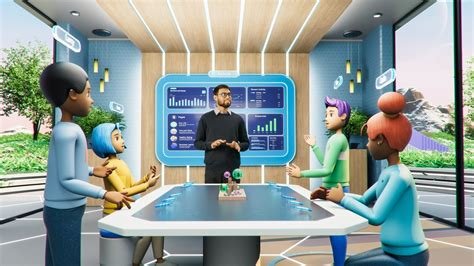The article How Virtual Reality Is Changing the Landscape of Social Interaction explores the transformative impact of virtual reality (VR) on how we connect with others. It discusses how virtual reality facilitates new forms of social engagement, enabling users to interact in immersive environments that transcend geographical limitations. Individuals can now attend virtual events, collaborate in meetings, or simply socialize in digital spaces, creating a dynamic and interactive way to build relationships. The blog also emphasizes key takeaways for embracing virtual reality in social settings, highlighting the importance of adapting to these evolving technologies for enriching interpersonal experiences. Overall, the article underscores the significance of understanding how virtual reality can redefine social interaction, making it an essential tool in today’s increasingly digital world.
Understanding The Impact Of Virtual Reality On Social Interaction
The advent of technology has consistently reshaped how we connect with one another, and one of the most significant innovations in recent years is virtual reality (VR). With VR, users can immerse themselves in fully interactive environments that mimic real-life settings. This transformative medium offers unprecedented opportunities for social interaction, allowing people to communicate and engage in ways that were previously unimaginable. Understanding the impact of virtual reality on social dynamics is essential in today’s digitally-oriented world, where placelessness takes on new significance.
As we assess the role of VR in social interaction, it’s important to highlight some key aspects to explore:
- The ability to connect users across geographical barriers.
- Enhanced emotional engagement through immersive experiences.
- The creation of diverse social environments.
- Opportunities for collaborative activities.
- Encouragement of participation from introverted individuals.
- Innovative methods for storytelling and shared experiences.
- Potential for educational and professional networking.
While these elements pave the way for groundbreaking social connections, we must also recognize the evolution of social spaces that virtual reality facilitates. Social spaces have traditionally been physical locations where individuals gather and interact. However, with VR, these spaces can be recreated in a virtual realm, offering an expansive range of environments tailored to different social needs. Avatars represent individuals, allowing users to express themselves without the constraints of physical appearances or limitations.
The Evolution Of Social Spaces
The transition from physical to virtual social spaces has been profound. VR social platforms have emerged as integral venues for gatherings, from casual meetups to formal events. Users can engage in dynamic experiences that encourage interaction, collaboration, and even competition. The immersive nature of VR ensures that the sense of presence can replicate, or even surpass, that of conventional formats, making social engagement richer than before. Such developments exemplify how how Virtual Reality is redefining the concept of social gatherings.
Virtual Reality in Different Cultures
Virtual reality’s impact on social interaction is not limited to a single culture but is a global phenomenon. Different cultures are leveraging VR to enhance their social landscapes, challenging traditional boundaries and enriching interpersonal connections. In many cases, VR brings cultural elements together that would otherwise remain isolated, allowing for shared experiences that bridge gaps in understanding. By fostering cross-cultural interactions, VR can promote tolerance and cohesiveness within diverse communities.
How Virtual Reality Facilitates New Forms Of Social Engagement
The rise of virtual reality technology has fundamentally altered the way we perceive social interaction. With environments that transcend the limitations of physical space, users now have the opportunity to connect with others globally, fostering relationships that were once deemed impossible. This innovative medium not only enhances communication but also shapes the very essence of community formation.
How Virtual reality serves as a bridge, linking individuals who share common interests and passions. These immersive experiences allow users to engage in an array of activities, from multiplayer gaming to virtual events, all while fostering a sense of presence and emotional connection. As users interact within these digital realms, they create unique communities that reflect their values and aspirations.
Steps To Engage Effectively
- Identify your interests and seek communities that align with them.
- Participate in forums or discussions within the virtual world.
- Engage with new users to build rapport and relationships.
- Attend virtual events to broaden your horizons.
- Utilize available tools to enhance your engagement experience.
- Share your experiences and invite others to join.
- Stay active to maintain and grow your connections.
Through these steps, users can effectively enhance their social experiences. The importance of balancing this new form of engagement with reality cannot be overstated.
Creating Virtual Communities
Virtual reality platforms have emerged as incubators for diverse communities, each with its unique culture and norms. These communities often focus on shared experiences, whether in gaming, education, or social gatherings. By allowing for spontaneous interactions, members can cultivate deeper relationships and build a sense of belonging. As social beings, humans naturally seek connection, and virtual reality enables this pursuit in ways never before possible.
Balancing Reality With Virtual Interaction
While the allure of virtual reality is undeniable, it is essential to achieve a balance between online presence and real-world interactions. Engaging in virtual spaces should complement rather than replace face-to-face relationships. Users must develop strategies to maintain personal relationships, ensuring that virtual experiences enhance their overall social engagement without overshadowing authentic connections.
Experiencing Events In Virtual Spaces
Virtual reality has revolutionized how we attend events, from concerts to conferences. These experiences allow individuals to partake in gatherings they may not be able to attend physically, breaking geographical barriers. Through interactive and immersive environments, users feel a part of the action, enhancing their social engagement. As technology continues to advance, the potential for new forms of social interaction within virtual spaces will only expand, further transforming how we connect and engage with one another.
Key Takeaways For Embracing Virtual Reality In Social Settings
As we explore the transformative potential of virtual reality (VR) in social interactions, it becomes evident that embracing this innovative technology can significantly change how we connect with others. One of the core benefits of VR is its ability to create immersive environments where users can interact in ways that were previously unimaginable. By stepping into a virtual realm, individuals can engage more deeply and meaningfully, thus enriching their social experiences. How Virtual environments present opportunities for creativity and connection that transcend physical barriers.
Utilizing VR in social settings often requires a mindset shift from traditional forms of interaction. To effectively integrate VR into your social life, it’s essential to remain open to new experiences. Adoption involves understanding the platforms available and selecting those that align with your interests and social goals. Virtual reality not only enhances personal interactions but can also facilitate networking and collaboration within various communities, allowing individuals to foster connections across the globe.
- Actionable Tips To Get Started
- Explore different VR platforms to find one that suits your social preferences.
- Join online communities focused on VR to learn from seasoned users.
- Attend VR meetups or events to experience social interactions firsthand.
- Invest in quality VR equipment for the best immersive experience.
- Practice using VR applications to build your confidence in virtual environments.
- Engage with friends in VR settings to enhance your collective experiences.
- Stay updated on VR trends to understand its evolving impact on social interaction.
Moreover, it’s crucial to cultivate an atmosphere of inclusivity and support within these virtual spheres. Your approach should prioritize building a welcoming environment where all participants feel comfortable to express themselves genuinely. This can involve setting guidelines for respectful interaction, actively listening to others, and encouraging diverse perspectives. When users embrace this supportive ethos, they contribute to a richer and more rewarding social experience for everyone involved.
In conclusion, adopting virtual reality in social settings lies in recognizing the unique opportunities it presents. By leveraging the tools available and committing to a collaborative spirit, individuals can unlock potential social interactions beyond their wildest dreams. How Virtual technology can redefine relationships and community building, creating bonds that are as meaningful as those formed in the physical world.









